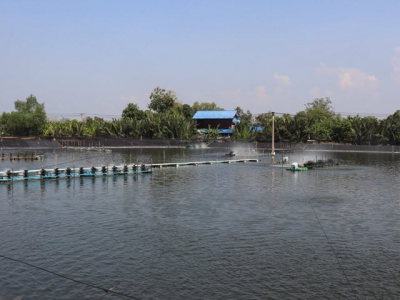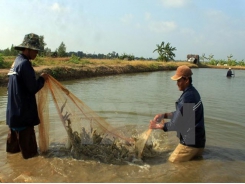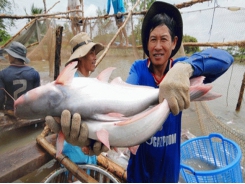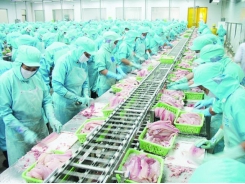Aquaculture and the Great Food Transformation

Aquaculture – unlike the production of red meat and dairy – has a key role to play in ensuring the world’s growing population receive sufficient nutrients, according to a ground-breaking new report on feeding the planet.
The paper argues for the sustainable intensification of aquaculture
Food in the Anthropocene: the EAT–Lancet Commission on healthy diets from sustainable food systems, published this week, has been written by 37 authors from 16 counties in various fields of human health, agriculture, political sciences, and environmental sustainability and aims to develop global scientific targets based on the best evidence available for healthy diets and sustainable food production.
They argue that a “Great Food Transformation” is needed but “will only be achieved through widespread, multisector, multilevel action that includes a substantial global shift towards healthy dietary patterns, large reductions in food loss and waste, and major improvements in food production practices.”
“820 million people have insufficient food and many more consume low-quality diets that cause micronutrient deficiencies and contribute to a substantial rise in the incidence of diet-related obesity and diet-related non-communicable diseases, including coronary heart disease, stroke, and diabetes… Because much of the world’s population is inadequately nourished and many environmental systems and processes are pushed beyond safe boundaries by food production, a global transformation of the food system is urgently needed,” it argues.
This healthy reference diet largely consists of vegetables, fruits, whole grains, legumes, nuts, and unsaturated oils, includes a low to moderate amount of seafood and poultry, and includes no or a low quantity of red meat, processed meat, added sugar, refined grains, and starchy vegetables
In order to achieve large-scale and coordinated efforts to transform the global food system, the authors argue that political pressure should be applied to ensure citizens move towards an increasingly healthy "reference diet".
“This healthy reference diet largely consists of vegetables, fruits, whole grains, legumes, nuts, and unsaturated oils, includes a low to moderate amount of seafood and poultry, and includes no or a low quantity of red meat, processed meat, added sugar, refined grains, and starchy vegetables,” they explain.
The role of seafood
The report points out that seafood, in particular that produced by sustainable aquaculture practices, will have an important role, albeit not as substantial as that of healthy vegetarian options.
“Seafood provides 3.1 billion people with about 20 per cent of their daily intake of animal protein and is particularly important for the world’s poorest for whom fish eaten whole constitute a crucial source of essential micro nutrients. With 90 per cent of global wild fish stocks being overfished or fished at capacity, seafood extraction potential from the wild has probably reached a ceiling or is declining. Future expansion of seafood should come from aquaculture, which is one of the fastest growing food production sectors in the world,” it states.
With global aquaculture production set to more than double by 2050, the report notes a number of options for this to be achieved sustainably.
Aquaculture will not solve the challenges posed by feeding about 10 billion people healthy diets but could help steer production of animal source proteins towards reduced environmental effects and enhanced health benefits
“Aquaculture production is projected to increase from 60 million tonnes in 2010 to 100 million tonnes in 2030, and up to 140 million tonnes by 2050. Key constraints include competition for feed resources and available land for freshwater farming. Research in sustainable aquaculture feeds is rapidly developing; however, development and implementation still remains in its infancy. Farmed non-feed dependent animal species (ie mussels and oysters) might be a more sustainable alternative than farmed feed-dependent species and account for 31 per cent of global aquaculture production. However, future development might be hampered by deteriorating water quality due to pollution and ocean acidification.
“The future environmental footprint of seafood depends on the species farmed, what they eat, and where aquaculture takes place. Aquaculture will not solve the challenges posed by feeding about 10 billion people healthy diets but could help steer production of animal source proteins towards reduced environmental effects and enhanced health benefits.

The paper voices concerns that poor water quality could hamper the growth of shellfish aquaculture
“Future risks and opportunities related to anticipated aquaculture expansion need to be managed. This management includes implementation of strict regulation on where to locate new operations, antibiotic and chemical use, nutrient runoff, and application of sustainably sourced feed from terrestrial and marine origin. Seafood transparency and eco-certification schemes can also be viable mechanisms for improving performance of the expanding seafood sector.”
Conclusions
While many of the report’s statistics are alarming, the good news is that they believe there is still time to ensure that 10 billion people can carve out a healthy and sustainable existence on the planet – as long as dietary habits are changed.
“Application of this framework to future projections of world development indicates that food systems can provide healthy diets… for an estimated global population of about 10 billion people by 2050 and remain within a safe operating space. However, even small increases in consumption of red meat or dairy foods would make this goal difficult or impossible to achieve,” they state.
"This Great Food Transformation will only be achieved through widespread, multisector, multilevel action that includes a substantial global shift towards healthy dietary patterns, large reductions in food loss and waste, and major improvements in food production practices. Data are sufficient and strong enough to warrant action; delay will increase the likelihood of not achieving the Sustainable Development Goals and the Paris Agreement. This Commission shows that a Great Food Transformation is both necessary and achievable," the report concludes.
Related news
Tools

Phối trộn thức ăn chăn nuôi

Pha dung dịch thủy canh

Định mức cho tôm ăn

Phối trộn phân bón NPK

Xác định tỷ lệ tôm sống

Chuyển đổi đơn vị phân bón

Xác định công suất sục khí

Chuyển đổi đơn vị tôm

Tính diện tích nhà kính

Tính thể tích ao




 Kiên Giang province will expand shrimp farming models…
Kiên Giang province will expand shrimp farming models…  Fishery exports 'cooled down' in the first month…
Fishery exports 'cooled down' in the first month…